The HTC One (M8) Review
by Anand Lal Shimpi & Joshua Ho on March 26, 2014 7:00 PM EST- Posted in
- Smartphones
- HTC
- Mobile
- HTC One
Battery Life
The new One features an integrated 3.8V 2600mAh battery (9.88 Wh), a 13% increase in capacity compared to the previous model. The battery comparison isn’t that simple however. The M8 has a larger display (5” vs 4.7”) but it also has a higher performing and more power efficient SoC (Snapdragon 801 vs. 600). To find out how the new One stacks up against its predecessor, we turn to a mix of old and new battery life tests to help better characterize the device.
We’ll start with our standard browser based battery life tests. Keep in mind here these tests are as much about replicating a particular CPU profile as they are about loading specific web pages in order.
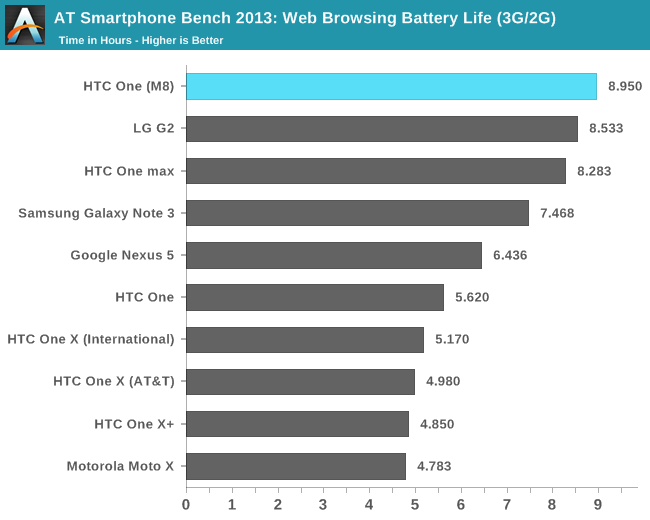
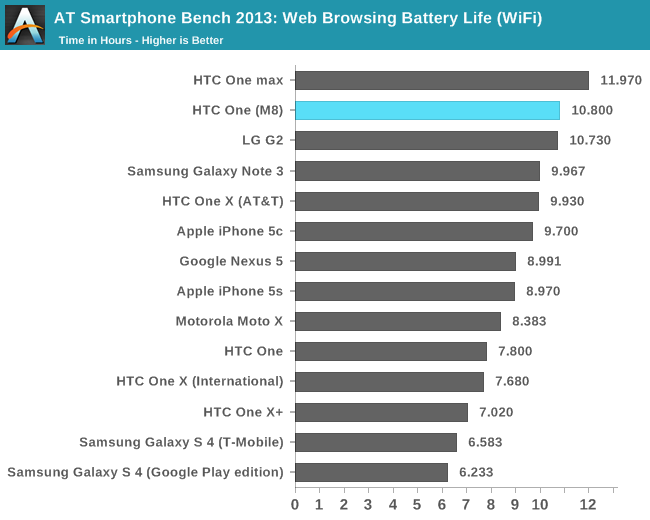
We saw a substantial gain in battery life with Snapdragon 800, and 801 extends that even further. For the same, relatively light (yet constant) workload, the M8 improves battery life over the M7 by as much as 71%. On WiFi the advantage drops to only 38%, but we’re still talking about absolutely huge generational gains.
A constant workload is only one part of the story though. More often than not, when you’re faced with faster compute you end up doing more. To see what the other extreme of battery life looks like I turned to two canned tests: BaseMark OS II and GFXBench 3.0.
I ran both of these tests under the same controlled conditions we always use, with all displays calibrated to 200 nits. BaseMark OS II runs through a bunch of CPU and storage benchmarks (basically the same tests used for the BaseMark OS II system and memory tests), as fast as possible, until the battery dies.
I like this benchmark as it gives us an indication of worst case battery life if you’re absolutely hammering the CPU (and storage) relentlessly.
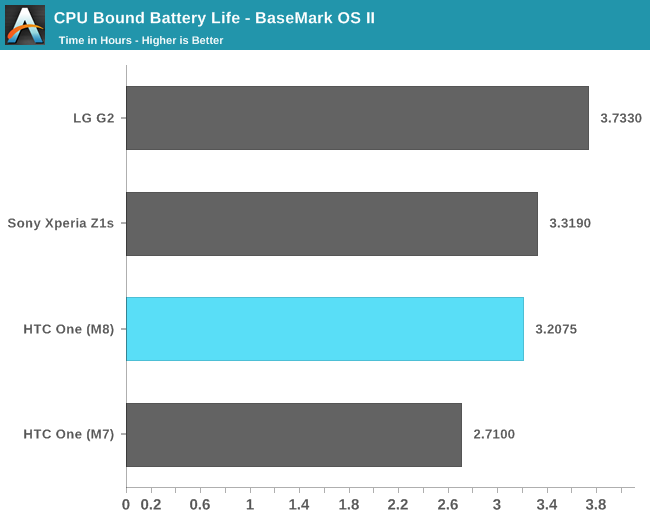
Despite the faster CPU cores, the M8’s battery life actually goes up compared to M7. Here we’re really seeing the benefits of 801’s updated 28nm HPm process compared to the Snapdragon 600’s 28nm LP process.
GFXBench provides a similar test, with effectively uncapped performance (on today’s devices at least since we’re not hitting v-sync limits), but stressing the GPU instead of the CPU. Here we’re running the T-Rex HD benchmark, onscreen, until the battery dies.

This is the first and only test we’ve got here that shows a regression in battery life compared to M7. The M8 loses about 6% of runtime compared to the M7, despite having a larger battery. Now look at what happens if we look at performance at the end of the run:
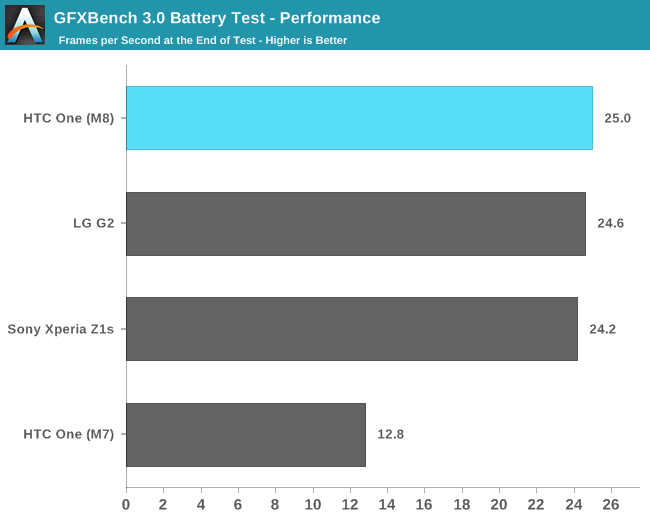
Now the M8’s battery life regression doesn’t look so bad. You give up 6% of runtime but you get almost twice the performance compared to M7. Snapdragon 801 is just a huge upgrade compared to 600.
Charge Time
The M8 features a Qualcomm Quick Charge 2.0 enabled PMIC, which enables faster battery charge times through higher voltage charging. Unfortunately the in-box wall adapter is only Quick Charge 1.5 compliant so you'll only pull 7.5W from the wall. HTC expects to offer a Quick Charge 2.0 compliant power adapter later this year.
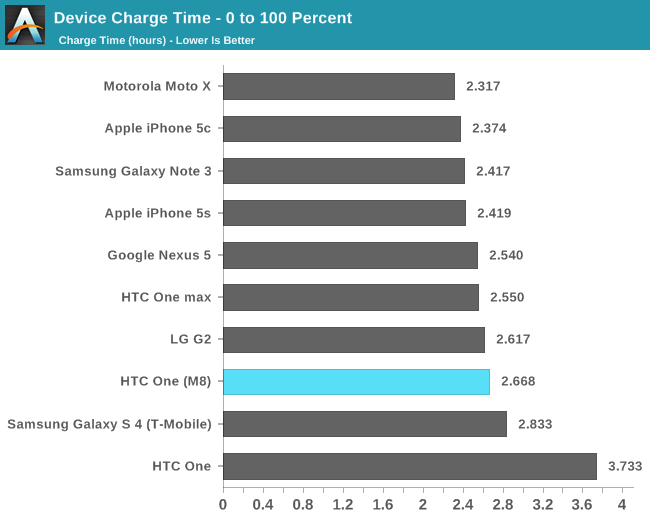
The M8's charge time is a bit slow compared to what we've seen from other devices with larger batteries.










222 Comments
View All Comments
tipoo - Wednesday, March 26, 2014 - link
I'm dying at the mustachioed Anand and the punk hat.bj_murphy - Thursday, March 27, 2014 - link
Yeah me too, that was my favourite part of the review, hands down!tzhu07 - Thursday, March 27, 2014 - link
HTC has a real-time 3D model of the M8. Pretty cool.https://skfb.ly/yvMN
skingtech - Tuesday, April 15, 2014 - link
This article helps convince me to go Samsung Galaxy S5 for sure. The M8 has a nice feature set - better built in sound and nicer look but, Samsung has better display, better camera, and comparable if not faster everything else (I don't know about you but, I put a case on my phone - the look of the device should be the LAST thing focus'd on for crying out loud.dylan522p - Wednesday, March 26, 2014 - link
I think those selfies may be the greatest thing ever!KPOM - Wednesday, March 26, 2014 - link
Nice review, as usual. I wonder if 5" is where phone manufacturers finally "stop" in terms of the "standard" phone size. Above that, and a small tablet paired with a 4-5" phone really is a better solution.If I were to get an Android phone, it would be an HTC. They should lobby hard to get a Nexus phone. With Google subsidies that might be what kicks their sales efforts into gear. Otherwise, I see the new HTC One in much the same light as the old HTC One: the best Android phone out there in terms of build quality and style, and one of the best in terms of performance, but a distant also-ran behind Samsung in terms of sales.
fokka - Wednesday, March 26, 2014 - link
i don't think we reached the end of increasing screen sizes yet. the one just hit 5", in a relatively big body though, the s5 jumped to 5,1", also by increasing body size. the z2 is at 5,2" and the only phones seemingly at least trying to offset the big screen with small bezels are the g2 and note3.the next note will be 5,9-6" and the next round of flagships will be in the 5,5" ballpark.
we can only hope for devices like the z1 compact to make top notch hardware available in more pocketable form factors.
Honest Accounting - Wednesday, March 26, 2014 - link
Moto X: optimal form factor and minimal bezels.I think we'll end up with 3 'standard' sizes. 4.7", 5.5", and 6.3"
piroroadkill - Thursday, March 27, 2014 - link
Yeah, Moto X is the right size.2.6mm shorter and 2.6mm narrower than my Motorola DROID RAZR MAXX HD. (Although the Moto X is thicker with a lot less battery!).
I still think if I had to pick any phone available, I'd stick with the one I have. The new DROID MAXX is closest to what I'd want, but it has no microSD slot or HDMI out, which the HD has both of.
Jeffrey Bosboom - Wednesday, March 26, 2014 - link
Can we get some remarks about audio quality? I use my phone for two things: taking pictures of whiteboards and listening to music. Given that my old EVO 3D's camera (and heavy JPEG compression) takes acceptable pictures, I think the ultrapixel camera will suffice. So if it also offers decent audio quality, I'll probably get one.